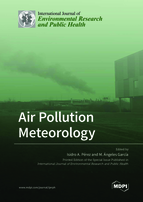Air Pollution Meteorology
A special issue of International Journal of Environmental Research and Public Health (ISSN 1660-4601). This special issue belongs to the section "Environmental Health".
Deadline for manuscript submissions: closed (30 September 2020) | Viewed by 26786
Special Issue Editors
Interests: air pollution meteorology; micrometeorology; statistics of meteorological observations; climate change
Special Issues, Collections and Topics in MDPI journals
Interests: air parcel trajectories; air pollution meteorology; climate change; greenhouse gases
Special Issues, Collections and Topics in MDPI journals
Special Issue Information
Dear colleagues,
Although air pollution is usually linked with human activities, natural processes may also determine noticeable concentrations of hazardous substances in the low atmosphere. The levels of pollutants may be reduced when emissions can be controlled. However, the impact of meteorological variables on concentrations measured may be marked, and these variables cannot be controlled. This Special Issue is devoted to the influence of meteorological processes on the pollutant concentrations recorded in the low atmosphere. The dilution of pollutants due to the development of the mixing layer or dispersion inhibition by temperature inversions are within the scope of this Issue. Moreover, studies about the influence of wind on concentrations and pollutant transport are welcome, since air parcels from densely polluted areas may reach remote sites where episodes of high concentrations may be observed occasionally and disturb the usual recorded values. Another research field covered by this Issue is the link between air pollution and precipitation. Coastal and mountain breezes introduce periodic changes whose impact on the air pollution should be quantified. Finally, air quality is markedly influenced by the micrometeorology of urban environments. This Special Issue is focused on applied science, and it is conceived to reinforce the knowledge of the contribution of meteorological processes on the concentrations measured in order to achieve a better control of air pollution.
Dr. Isidro A. Pérez
Dr. M. Ángeles García
Guest Editors
Manuscript Submission Information
Manuscripts should be submitted online at www.mdpi.com by registering and logging in to this website. Once you are registered, click here to go to the submission form. Manuscripts can be submitted until the deadline. All submissions that pass pre-check are peer-reviewed. Accepted papers will be published continuously in the journal (as soon as accepted) and will be listed together on the special issue website. Research articles, review articles as well as short communications are invited. For planned papers, a title and short abstract (about 100 words) can be sent to the Editorial Office for announcement on this website.
Submitted manuscripts should not have been published previously, nor be under consideration for publication elsewhere (except conference proceedings papers). All manuscripts are thoroughly refereed through a single-blind peer-review process. A guide for authors and other relevant information for submission of manuscripts is available on the Instructions for Authors page. International Journal of Environmental Research and Public Health is an international peer-reviewed open access monthly journal published by MDPI.
Please visit the Instructions for Authors page before submitting a manuscript. The Article Processing Charge (APC) for publication in this open access journal is 2500 CHF (Swiss Francs). Submitted papers should be well formatted and use good English. Authors may use MDPI's English editing service prior to publication or during author revisions.
Keywords
- Air quality
- Statistical analysis
- Micrometeorology
- Air flow
- Weather events
- Air pollution episodes
- Pollutant dispersion







